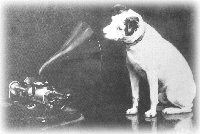The History of Recorded Music
1800's| 1900's-1920's | 1930's-1950's | 1960's-1980's | 1990's-2000's |
| The Beginning (1800's): 1857 Frenchman Leon Scott invented the phonautograph which translated fluctuating air pressures into a scribed trace on a smoked cylinder by means of a stylus attached to a membrane. The resulting transcription could not reproduce the sound. 1877 In April another Frenchman, Charles Cros, a poet and inventor of photographic colour processes proposed that Scott?s method be improved by photoengraving the trace onto metal with the possibility of retracing the pattern resulting in the replay of the original sound. In July Thomas Alva Edison, the prolific American inventor, discovered a method of recording and replaying sound having followed a somewhat different line of research from Scott or Cros. He filed a provisional specification for a British patent 2909/1877. On December 24, Edison applied for the US Patent 200 521 which covered talking machines and sound writers to be known as Phonographs. The first phonographs used tin foil cylinders. 1878 Edison considered the use of compressed amplifiers to overcome the problem of lack of replay volume. The Englishmen, Horace Short and C.A. Parsons (the steam turbine expert) succeeded in perfecting the compressed air amplifiers known as Auxetophones but they were eventually used for other purposes. 1884 Emile Berliner, an American of German origin, recorded ?The Lord?s Prayer? on an Edison cylinder machine. The original recording is preserved by the BBC in London. 1886 Edison was granted US patent 341 214 for a wax coated recording cylinder. This signified the beginning of the end of the tin foil coated cylinder. 1887 Berliner developed a successful method of modulating the sound-carrying groove laterally in the surface of a disc. (The groove on cylinders was modulated vertically.) He also invented a method of mass producing copies of an original recorded disc. 1888 Jesse Lippincott, a financier, took over the commercial exploitation of the Phonograph and the Graphophone as dictating machines on a lease and service contract. The Graphophone had been developed by Edison?s rivals, Chichester Bell (the brother of Alexander Graham Bell) and Charles Tainter at the Volta laboratory and in terms of ease of operation and fidelity of sound reproduction it was a vast improvement on the phonograph. The use of either machine as an entertainment medium was still seen as a novelty. 1889 Coin-in-the slot public access replay facilities, a primitive form of juke box, which could be used in amusement arcades, became immensely popular in the US creating a demand for entertainment recordings, mainly comic monologues. 1890 Edison?s Phonograph and the Bell-Tainter Graphophone were in intense competition for the popular market. The Phonograph was beginning to prove the more popular, and the New York Phonograph Company opened the first purpose-built recording studios. 1894 Pathe Freres started the world famous French company making phonographs and cylinders. 1895 By now recorded music as a medium of entertainment had become firmly established with the public. The demand for recordings provided the incentive for research and investment in the infant record business. 1896 Eldridge R. Johnson designed and manufactured a ?clockwork? spring motor which helped establish F. Seaman?s National Gramophone Company of New York as a serious rival to the Phonograph and the Graphophone Companies. | |
| Next | |
Source : http://www.ifpi.org/
 For centuries man had dreamed of capturing the
sounds and music of his environment. Many had attempted it but no one had succeeded until Thomas
Alva Edison discovered a method of recording and playing back sound. What had started out as an
apparatus intended as part of an improved telephone led to the development of an instrument which
would change the world, making it a happier, even a better, place to live. Here are the facts, in
reverse order:
For centuries man had dreamed of capturing the
sounds and music of his environment. Many had attempted it but no one had succeeded until Thomas
Alva Edison discovered a method of recording and playing back sound. What had started out as an
apparatus intended as part of an improved telephone led to the development of an instrument which
would change the world, making it a happier, even a better, place to live. Here are the facts, in
reverse order: